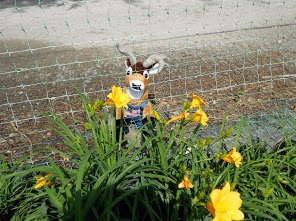
by Julie McConnell | Jul 27, 2015

Deer are known to eat daylilies in the landscape. To prevent browsing, choose other plants or create a barrier with deer fencing.
Any seasoned gardener knows that even a well maintained garden will eventually face a pest issue. Pests come in all shapes and sizes and may include weeds, disease, insects, moles, rabbits, birds, and deer. Although some gardeners may invite wildlife into their gardens when that adorable deer eats your prized hydrangea it tends to lose the cuteness factor.
Regardless of what type of pest issue you are facing, the only way to establish a successful control program is to correctly identify and understand some basic things about the pest. Incorrect assumptions or misidentification can lead to taking the wrong action and may even cause more harm to plants.
Some things to know about your pest (after identification):
- Preferred host or target plant – diversify landscapes to minimize susceptibility to each pest.
- Feeding/damage caused – is it just aesthetic or will it cause long-term harm?
- For rapidly reproducing pests such as insects or fungi, what is the timing of new generations? For example, if you eliminate adult insects expect that eggs are waiting to hatch – you need to know when to retreat.
- What natural enemies might help reduce populations and how can they be preserved?
- Be sure to match control methods with pest behavior and activity. For example, if you want to use an insecticidal soap on azalea lace but you need to know that they feed from the underside of the leaf in order to properly coat them with the product.
Take the time to get to know the pest in your backyard and management efforts will be much more effective. For help with identification and control, contact your local extension office.
by Julie McConnell | Jun 30, 2015
If you’ve been gardening for more than a few years, you may be confused by UF/IFAS recommendations that conflict with practices you’ve used for years. You aren’t imagining things, we do change recommendations based on the most current research available to help you with your agricultural endeavors.
I want to share a few common mistakes that gardeners make based on old recommendations but that research has shown are not the best choices. Check out the list below to see if you can break an old habit or two!
| Old Habit |
Current Recommendation |
| Throw a little “starter fertilizer” in the hole (or under new sod, seed, etc.) |
It is not beneficial to add fertilizer to plantinghole or under newly installed sod.Quick release (soluble) fertilizer may burn roots if added to planting hole.If applied properly, a slow release fertilizer may be applied to trees and shrubs but should be applied to the top of root ball or mulch following label instructions.Turfgrass grown from seed, sprig, or sod does not use fertilizer efficiently at planting. Wait 30 days to apply fertilizer – after roots have been established. |
| Dig the hole twice as deep and wide as the root ball for trees and shrubs |
1.5 times the width of the root ball is good, but planting too deep can be a death sentence.Planting depth should be 10% shallower than the distance from the topmost root to the base of the root ball. |
| Mulch 3-5 inches deep |
2-3 inches with a very thin layer directly over the rootball (less than 1 inch) and none touching trunk. This is the ideal amount to conserve water and suppress weeds. |
| Native and drought tolerant plants don’t need water |
All plants need water until established – depending on the type and size of the plant, weather, and soil conditions this may take months.Always plan to give a little TLC to newly installed plants no matter how tough they are supposed to be. |
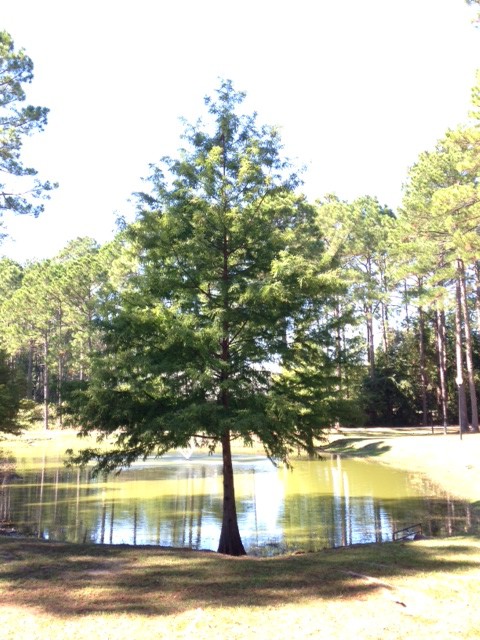
by Julie McConnell | Jun 2, 2015
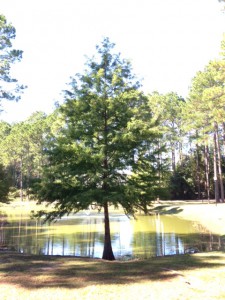
Bald cypress growing at the edge of a pond. Photo: Julie McConnell, UF/IFAS
Considering planting a tree in your landscape, but not sure what will do well?
Baldcypress, Taxodium distichum, is one tree you should consider for your Florida landscape. This deciduous conifer is native to North America and is suited to a wide variety of situations, even difficult ones!
Baldcypress is found naturally along stream banks and in swampy areas, but also performs well in dry situations once established. Not many trees can tolerate standing water or flooding situations, but baldcypress is well adapted to these tough spots. In areas that flood or remain wet the tree will form “knees” that project out of the ground and add a beautiful feature – just don’t plan to mow in areas where these develop. Not restricted to wet areas, baldcypress also performs well as a street tree or in limited root zone situations such as parking lot islands.
This tough tree has a soft, delicate leaf texture and interesting globular cones that start out green then turn brown as they mature. The foliage is light green through the spring and summer then turns a coppery gold before the needles fall in the winter. The trunk has a reddish color that is also attractive and will grow branches low to the ground, but can easily be maintained with a clear trunk in a street tree form.
Baldcypress will grow in full sun to part shade and is adapted to all soil types except highly alkaline (over 7.5 pH). Sand, loam, clay, or muck can all sustain this native tree. Few pests bother baldcypress, but it can be affected by bagworms and mites. Mature size can be in excess of 100 feet, but trees typically grow 60-80 feet tall in Florida.
For more information:
Taxodium distichum: Baldcypress
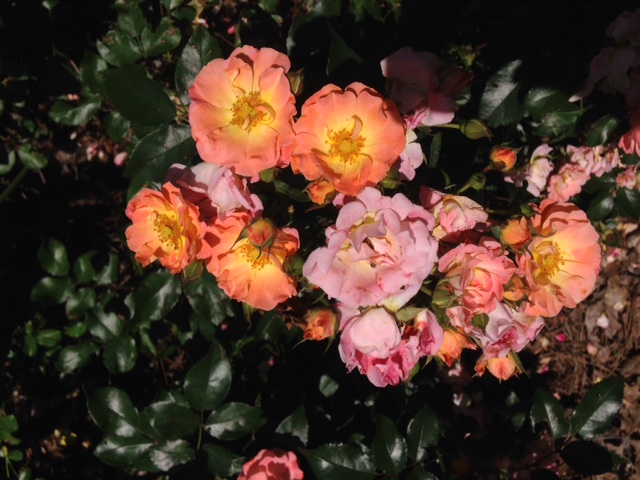
by Julie McConnell | May 6, 2015
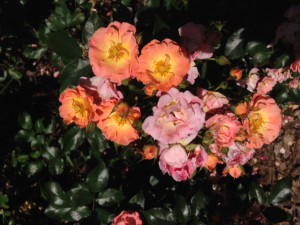
Peach Drift® Rose blooming in Quincy at the UF/IFAS NFREC Photo: J.McConnell, UF/IFAS
Growing roses in the South can have challenges and many gardeners think that they are just too high maintenance to plant. Plant developers are aware of this opinion and have worked to develop low maintenance roses that can make a novice gardener look like a pro.
The trend in horticulture is to develop and release plant series where closely related plants have similar characteristics but offer some diversity such as different flower color and size. A new series that is performing well in North Florida is Drift® Groundcover Roses. Available with flower colors ranging from white, yellow, pink, apricot, to red. All exhibit a low growing habit and will remain under three feet tall and spread up to four feet wide. Flowers are born in dense clusters for most of the year, only taking a break in the winter months.
Although not completely disease free, these roses do show resistance to rust, powdery mildew, and black spot which are common problems with roses. Deadheading is not necessary, but can be done to increase bloom and keep plants looking tidy. One of the best characteristics of the Drift® Groundcover Rose series is that they don’t get very tall, so they fit in small spaces. If you are looking for incredible color in a sunny site with limited space give this series a try.
Although low maintenance, roses do still require some attention, for more information read Growing Roses in Florida.
by Julie McConnell | Apr 13, 2015
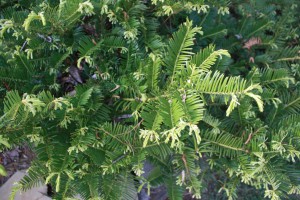
New foliage of Japanese Plum Yew Photo credit: Julie McConnell, UF/IFAS
Trying to grow turfgrass in shaded areas is a losing battle but that doesn’t mean you have to settle for mulch in those dark areas of the landscape. There are many plants that will tolerate shady conditions found under the canopy of large trees, and some offer year round interest!
One of the most important aspects of site assessment is sun exposure. Plants need light, but do not all need the same amount or intensity.
If plants requiring full sun are planted in the shade, they tend to get leggy and do not flower well. Although they may live, they will not perform at their peak.
Shade loving plants grown in the sun may be stunted, show leaf scorch, and will struggle. Most shade plants can tolerate some filtered light or morning sun, but need to be protected from direct mid-day to afternoon sun.
So, what evergreen plants can add some color and texture to your shaded spots?
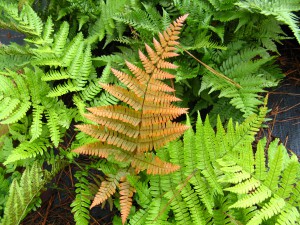
Golden tones of new foliage is what gives Autumn Fern its common name. Photo credit: Julie McConnell, UF/IFAS
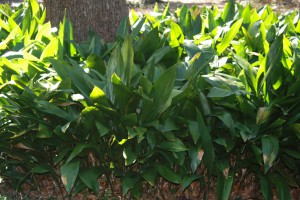
Cast Iron Plants under a live oak tree. Photo credit: Julie McConnell, UF/IFAS
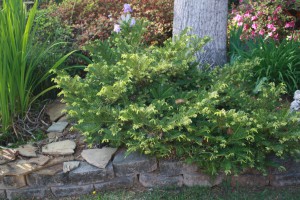
Japanese Plum Yew. Photo credit: Julie McConnell, UF/IFAS
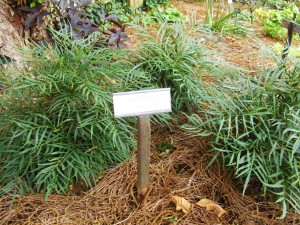
Soft Caress Mahonia. Photo Credit: Julie McConnell, UF/IFAS











